If you read our previous opera post, “Opera Voice Types,” then you might be shocked to see another opera-centered article. Can there really be MORE to learn about the parts of an opera?
Yep. A whole lot more.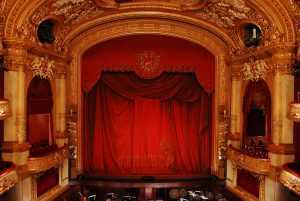
Opera is a huge undertaking, made up of many different parts: overtures, acts, arias, and recitatives just to name a few. We’ll cover those in this article.
The more you know about opera, the more interesting it becomes–you may even find yourself buying tickets to a performance soon. If you don’t get to know the genre at all though, opera will probably look strange and unapproachable. We can understand why.
So grab a cup of coffee and spend some time with these parts of an opera. You’ll be glad you did, and we’ve included lots of examples. If you get lost, let us know in the comments below!
Overture
The history of the opera overture goes back to the very beginning of the 17th century. Instruments were different back then (think gut strings and the violoncello), the symphony hadn’t been invented yet, and opera was just getting started. Thanks to guys like Peri, Caccini, and Monteverdi, operas and overtures were able to get off the ground.
Parts of an Opera: The Early History of the Overture
The word “overture” comes from the Latin word “apertura.” You may be familiar with the English word “aperture,” which refers to an opening or a hole. Considering the origins of the word, it comes as no surprise that “overture” is often used to describe the instrumental opening of an opera prior to the beginning of Act 1.
[su_box title=”Side Note on Acts” box_color=”#6a1db0″ title_color=”#fefefe” radius=”0″ class=”width: 200px;height: 400px;”]Operas are made up of “Acts;” the composer decides how many acts, or sections, are in the opera. The number is generally from one to five. In a live performance, intermissions will occur between acts, but not necessarily between every act. Example: in a four-act opera, there may be an intermission only after the second act. Surprisingly, one-act operas are not necessarily shorter–Wagner’s Das Rheingold has only one act but it runs for two and a half hours![/su_box]
The roots of the opera Overture begin with the first surviving opera, Peri’s L’Euridice in the year 1600 (it should be noted that Peri composed an earlier opera, Dafne, but manuscripts of the music have not survived). Peri included an instrumental “ritornello” at the beginning of the opera; with that ritornello came the first hints of the parts of an opera that would eventually become the full-blown overture.
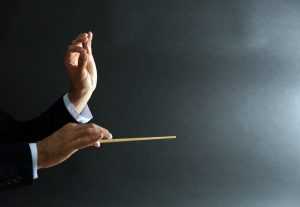 Monteverdi composed his influential L’Orfeo just a few years later in 1607. He opened with a toccata performed by the trumpet, and this toccata further contributed to the rise of purely instrumental introductions (or overtures) in opera.
Monteverdi composed his influential L’Orfeo just a few years later in 1607. He opened with a toccata performed by the trumpet, and this toccata further contributed to the rise of purely instrumental introductions (or overtures) in opera.
It was Jean-Baptiste Lully, a French composer in the first half of the 17th century, who brought the overture to the forefront of operatic form though. In fact, he was the first composer to call his opening section an “ouverture” starting with his ballets in the 1640s.
Not only did he introduce the overture as one of the formulaic parts of on opera (operas henceforth needed an overture), but he also created a distinct kind of overture that we refer to today as the “French Overture.”
Lully’s “French Overtures” followed a fast-slow, A-B pattern in two parts:
- His first section took advantage of a distinct dotted rhythm–give it a listen on this recording of his opera, Thesee. The first part of his French Overture was also very slow, stately, and almost ponderous.
- The second section of Lully’s “ouvertures” speed up into a lively fugato, livening the mood for the entrance of the vocalists.
Purcell upheld Lully’s mantle in the 1680s (exact date is unknown) with his composition of the miniature opera Dido and Aeneas; he maintained the same A-B structure of Lully’s opera and ballet overtures.
The Beginnings of the Italian Overture
It was about time for a composer to “mix things up” by the time Purcell’s Dido and Aeneas starting topping the late Baroque charts. Alessandro Scarlatti (the father of Domenico) took it upon himself to introduce something new.
He came up with a three section overture in the 1680s, as opposed to Lully’s two. Scarlatti also employed a fast-slow-fast form (perhaps he thought audiences were harder to engage when the slow movement came first). To hear a bit of late 17th century Scarlatti opera that showcases his new overture style, listen to La Rosaura. He wrote it in 1690.
Scarlatti’s Italian Overture style took Europe by storm during his lifetime, and not only did it supplant Lully’s binary form as the preeminent style of overture, it formed the foundation of the classical symphony. In fact, Beethoven’s stand-alone overtures of the early 19th century are direct descendants of Scarlatti’s overture form (listen to Beethoven’s Zur Namensfeier, for instance), and Mendelssohn’s contributions to the overture repertoire continued the trend. Symphonic poems would be related to this trend as well.
The Foundation of the Modern Opera Overture
Thanks to Christoph Gluck (1714-1787), overtures started relating more and more the body of the opera itself. Gluck believed that an overture should foreshadow the plot and mood of the 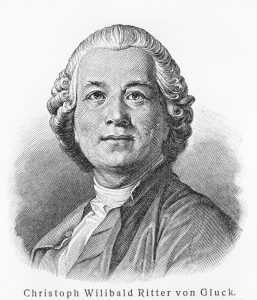 opera–the audience should be prepared by the orchestra for what would follow later. His opera Alceste offers an early example of this mindset.
opera–the audience should be prepared by the orchestra for what would follow later. His opera Alceste offers an early example of this mindset.
Mozart’s Don Giovanni picked up on this methodology, and composers have followed to a certain extent ever since. By the late 18th century, composers like Verdi and Wagner began using a through-composed prelude rather than a strict A-B-A form overture, but the thought process remained the same; the audience should be prepared by the introduction for what was coming next.
Parts of an Opera: History of the Aria
In 1602, a composer named Giulio Caccini released a new collection of solo songs called Nuove Musiche (The New Music) in monodic style rather than the more traditional polyphonic style. This basically means that the songs featured a solo melody line with accompaniment. The songs had verses (meaning they were “strophic”), and they featured embellishments for the singer upon returning to previously sung material. Does this sound a lot like the operatic aria to you?
Well, Caccini referred to individual songs from his collection as “Arie.” Thus the “Aria” was born.
In opera, the aria is a solo melody performed with accompaniment during the body of the opera itself, and Monteverdi’s 1607 opera L’Orfeo was the first to employ aria as we know it. After that, arias became a staple of the opera genre, and cantatas and oratorios regularly employed them as well. Remember that arias didn’t only refer to songs in an opera during the early 17th century–they included a wide variety of strophic vocal songs.
The Evolution of Arias
Like other parts of an opera, the aria followed a similar path to the overture; it began in A-B (binary) form, and it evolved into A-B-A (ternary) form.
By the middle of the 17th century, Lully had started popularizing “extended binary” arias into his French Opera style. What do we mean by extended binary? In short, extended binary arias followed an A-B-B form: the aria had distinct A and B sections, and the secondary B section could revisit previous material and/or alter it as the composer pleased. Lully also employed the beginnings of “rondo” form into his French operas by using an A-B-A-C-A-D… structure. Basically, the A theme would keep returning.
Alessandro Scarlatti (who was born in 1660) was the composer who essentially turned the Da Capo aria into the preferred aria style in Italian Opera. He began to use A-B-A form, in which the singer returns to the A section after the B section and embellishes it with trills, scales, and other virtuosic elements. “Da Capo” literally means “from the head,” so the return to the A section is just a literal realization of the name.
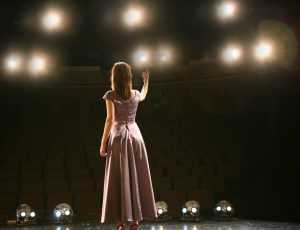 The Da Capo aria remained the most respective form of aria for most of the 18th century, but by the late 1700s, Jean-Jacques Rousseau and Gluck began to criticize its distracting elements. They thought there was too much embellishment and drama in Da Capo arias—these parts of an opera just didn’t add to the plot or music of the show anymore. And singers were calling attention to themselves rather than to the overall performance.
The Da Capo aria remained the most respective form of aria for most of the 18th century, but by the late 1700s, Jean-Jacques Rousseau and Gluck began to criticize its distracting elements. They thought there was too much embellishment and drama in Da Capo arias—these parts of an opera just didn’t add to the plot or music of the show anymore. And singers were calling attention to themselves rather than to the overall performance.
In fact, a phenomenon known as the “insertion aria” started to take shape. Singers would use whatever aria they wanted during the opera, whether or not it had something to do with the plot or music. These arias were also called “suitcase arias,” and famous singers would carry their favorite “suitcase aria” with them on tour. Opera audiences even jumped on board with this practice; they would be disappointed if a singer didn’t perform his/her “trademark” aria during a performance.
Aria Evolution Continued…
While the arias of Lully, Scarlatti, and Gluck dominated the opera world for a long time, new forms of experimentation eventually took over.
Operatic arias started to regularly appear in two distinct halves again around the year 1800 (you might be thinking that 2-part arias are nothing new–you’re right. The beginnings of “binary” arias were back in 1607). Mozart’s Don Giovanni, for instance, included the famous “Catalogue Aria,” sung by Leporello, and it had one dramatic half and one virtuosic half.
This kind of aria came to be known as the “cabaletta” aria, and it was usually preceded by a recitative (we’ll get to the recitative parts of an opera next). Here is the common use of the cabaletta aria:
Recitative → Cabaletta Pt. 1 (usually lyrical) → Cabaletta Pt. 2 (usually virtuosic)
Moving forward through the 19th century, you’ll notice that arias started migrating from formulaic rigor towards an emphasis on narrative–in other words, the story, not the form, was most important. You’ll notice the trend if you listen to Verdi’s Rigoletto.
Wagner took this trend even further in the latter half of the 19th century, as his operas and arias post-1850 were largely through-composed. If you listen to Parsifal, for instance, you will hear original music at every turn rather than a constant revisiting of previously-sung material.
Parts of an Opera: The Recitative
Recitative refers to the parts of an opera in which a performer imitates the rhythm of the spoken word. Recitative passages are usually sung on a repeated note or just a few notes, and there is no melody. Furthermore, the singer doesn’t repeat any words or sections of a recitative as he would in a strophic aria.
In short, recitative is used in place of spoken words, and it serves to drive the plot forward rather than to present new musical material. Recitative is accompanied sparsely, but the extent of the accompaniment depends on the nature of the recitative–we’ll discuss the two general kinds of recitative in a moment.
History of Recitative: The Early Beginnings
By now you might be tired of hearing about Jacopo Peri’s Euridice (from the year 1600), but wouldn’t you know–operatic recitative was born right here in the first known opera. The recitative in Euridice wasn’t exactly how we know it today, but the majority of the opera was written in a lyrical recitative style. Given the fact that Caccini had not yet released his “New Music” and the aria wasn’t yet in vogue, Peri’s recitative would have had to be somewhat lyrical to make Euridice interesting.
It may not be able to hold your attention for an hour and forty minutes, but here’s a recording anyway.
Throughout the rest of the 17th century, opera composers relied upon the aria for emotion and artistry, not to mention virtuosity. For practicality’s sake, major plot points and dialogue were left to the recitative (that’s not to say that recitative isn’t artistic or difficult to sing well!). Regarding form, an aria would usually follow the recitative, a practice that has continued throughout much of opera’s history.
The Two Main Types of Recitative
Recitative falls into two sub categories: Recitativo Secco and Recitativo Stromentato
We’ll start with Recitativo Secco, which literally means “dry recitative.” No, it has nothing to do with white wine–it has everything to do with the amount of instrumental accompaniment 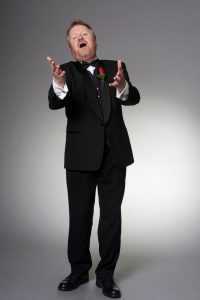 underneath.
underneath.
Recitativo Secco has a stark and bare sound, accompanied by only minimal instrumentation. These parts of an opera feature a freer rhythmic style (facilitated by the accompaniment only playing sustained chords), and the singer can do as he or she pleases, to a certain extent. Secco formed the backbone of the above-mentioned Peri and Monteverdi operas. Secco recitative was traditionally accompanied by harpsichord, bass viol, and violoncello.
For sake of reference, imagine a Broadway musical (probably Hamilton, these days). Any instance where the performers communicate with spoken words, an opera performer would communicate with recitative.
Recitativo Stromentato differs from “dry” recitative in that the rhythms are dictated and should be followed. Also, these parts of an opera are accompanied by a more lush instrumentation–traditionally the string section instead of just a harpsichord, bass viol, and violoncello. Handel’s Messiah (which is an English speaking oratorio, not an opera), and “Comfort Ye” in particular, provides wonderful examples of Recitativo Stromentato.
Ensembles in Opera: Choruses, Duets, and Beyond
Opera would get pretty bland if only one character sang at a time for the duration of the performance. Fortunately for us listeners, composers have always employed ensembles as parts of an opera. Technically, an ensemble can refer to a duet, trio, quartet, chorus, or any group of performers singing together. More often than not, the word “ensemble” refers to a time in the opera when multiple characters are portraying conflicting emotions at the same time.
Here are the different types of ensemble in opera, as well as some famous examples of each.
- The first and most common sort of ensemble you’ll hear in an opera is also the biggest one–the chorus. According to Scottish Opera, “The choruses in opera usually represent groups such as soldiers, priests, peasants, nymphs of the woods and so on – whatever is required by the story.” We highly recommend that you give Verdi’s famous “Anvil Chorus” from Il Trovatore.
Another wonderful example of a chorus is the opening to Act II of Puccini’s La Boheme. The village people serve two purposes: they fulfill the need for Puccini to “mix things up” musically with a chorus scene, and they further the plot and the imagery of a bustling European town.
- “Don’t Go Breaking My Heart,” “Empire State of Mind,” and “Endless Love” might come to mind when you think about duets, but duo vocal features were popular in opera long before Alicia Keys and Lionel Richie took over the duet genre.
By definition, duets occur when two people (in this case, singers) performed together.
Operatic duets got their start back in 1607, when Monteverdi wrote a duet into the score for two characters, Proserpina and Plutone, in his opera L’Orfeo. Throughout the rest of the 17th century, Opera Seria composers would add humor to their shows with duets during comical scenes, and as the history of opera progressed, composers used duets to show friendship, love, vengeance, arguments, and just about anything else you can think of.
[su_box title=” Side Note on Opera Seria” box_color=”#6a1db0″ title_color=”#fefefe” radius=”0″ class=”width: 200px;height: 400px;”] Seria refers to the period of serious Italian opera than dominated the 18th century. Alessandro Scarlatti was the instigator of this Italian form, and his Da Capo arias became the aria of choice during this period. Opera Seria is sometimes referred to as Neapolitan Opera. Gluck’s Orfeo ed Euridice came at the end of opera seria’s reign and signalled the end of the flowery and often overdone arias of the seria period. For contrast, the Paisiello Barber of Seville (first performed in 1782) would be an example of Italian opera “buffa.” Buffa, the humorous counterpart of late Opera Seria, grew out of the interludes in opera seria.[/su_box]
Operatic duets usually fall into one of two categories though: love duets, or conflict duets. In other words, the two characters on stage are either professing their deep feelings for one another in some way, or they are expressing displeasure, disagreement, or outright violence. Rarely is there middle ground between these two forms of duet.
For a great example of a love duet, watch this Placido Domingo video of Wagner’s Tristan und Isolde. The duet is entitled “Descend, O Night of Love.” The “Princess of Death” duet from Puccini’s Turandot (between the prince and Turandot) offers an example of a conflict-centered opera aria.
Believe it or not, there are duets that fall outside of the passionate love/argument category. The famous “Flower Duet” from Lakmė features two sopranos (a leading character and her servant) singing as they simply gather flowers by a river.
Another example of a duet that is neither a love affair nor an argument would be the “Pearl Fishers” duet by Bizet. Simply put, this duet simply features two guys from the opera Les pêcheurs de perles singing about their friendship. It all depends on which parts of an opera the duet fits into.
- Larger ensemble numbers such as trios and quartets take place in opera as well, usually for the sake of the plot. Listen to “Dieu qui fit l’home à ton image” from Gounod’s Romeo and Juliet, for instance, or explore the love triangles in Bellini’s operas (you’ll find plenty of trios there). “Ah! taci ingiusto core” is a famous trio from Mozart’s Don Giovanni, and you can enjoy the “Al suon del tamburo” trio from Verdi’s La Forza del Destino as well.
We hope you have enjoyed our exploration into the parts of an opera! If you have any questions, thoughts, or favorite operas, let us know in the comments below!

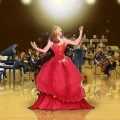
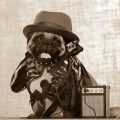
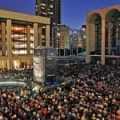
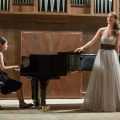


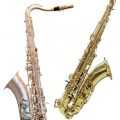
A precious piece of information on Opera's structure, dear Mr. Gingery!
I write novels, short stories and plays – as a matter of fact, I was in want of this knowledge to make my texts for children's plays look and sound more like operetta librettoes. Thank you very much.